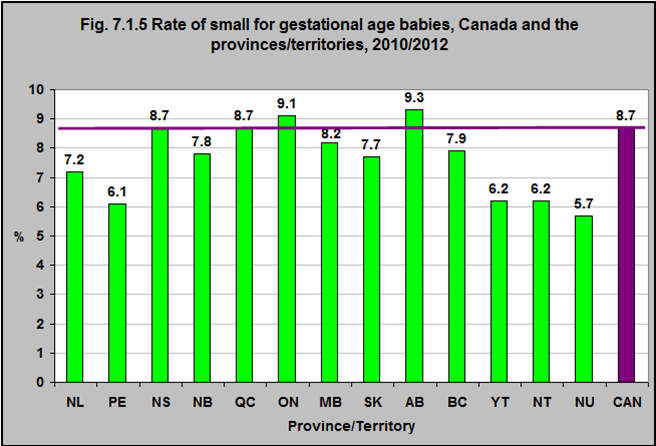Rate of small for gestational age babies, Canada and the provinces/territories, 2010/2012

Note:
Small for gestational age births are defined as live births with a birth weight less than the 10th percentile of birth weights of the same sex and the same gestational age in weeks according to norms taken from Kramer et al. “A New and Improved Population-based Canadian Reference for Birth Weight for Gestational Age”. Expressed as a percentage of live singleton births..
Source: CICH graphic created using data adapted from Statistics Canada. Table 102-4318 – Birth-related indicators (low and high birth weight, small and large for gestational age, pre-term births), by sex, three-year average, Canada, provinces, territories, census metropolitan areas and metropolitan influence zones, occasional (number unless otherwise noted). http://www5.statcan.gc.ca/cansim/a26?lang=eng&retrLang=eng&id=1024318&&pattern=&stByVal=1&p1=1&p2=-1&tabMode=dataTable&csid= – accessed June 20, 2017.
In 2010/12, the rate of small for gestational age babies varied between provinces and territories.
The rate was highest in Alberta (9.3%) and Ontario (9.1%) and lowest in Nunavut (5.7%) and Prince Edward Island (6.1%).
Implications
Babies who are born small for their gestational age are at increased risk of fetal and infant illness and death, and are more likely to be low birth weight.1 For example, babies born small for their gestational age are at increased risk of having heart disease later in life. As well they are at increased risk of cognitive and behavioural problems.2
1Public Health Agency of Canada. Canadian Perinatal Health Report: 2008 edition. Ottawa, ON: Public Health Agency of Canada. http://www.phac-aspc.gc.ca/publicat/2008/cphr-rspc/pdf/cphr-rspc08-eng.pdf – accessed June 20, 2017.
2Lundgren Em and Tuvemo T. Effects of being born small for gestational age on long-term intellectual performance. Best Pract Res Clin Endocrinol Metab. 2008 Jun;22(3):477-88.
